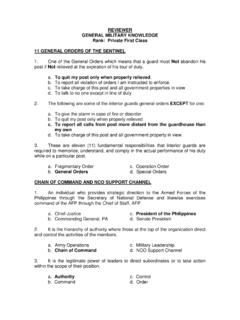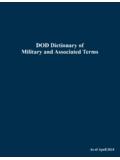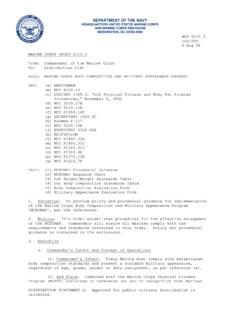Transcription of The Islamic State and U.S. Policy - FAS
1 The Islamic State and Policy Christopher M. Blanchard Specialist in Middle Eastern Affairs Carla E. Humud Analyst in Middle Eastern and African Affairs February 2, 2017. Congressional Research Service 7-5700. R43612. The Islamic State and Policy Summary The Islamic State (IS, aka the Islamic State of Iraq and the Levant, ISIL/ISIS, or the Arabic acronym Da'esh) is a transnational Sunni Islamist insurgent and terrorist group that controls large areas of Iraq and Syria, has affiliates in several other countries, has attracted a network of global supporters, and disrupts international security with its campaigns of violence and terrorism. The coalition military campaign against the Islamic State organization in Iraq and Syria has adapted since 2014, as Administration officials and coalition partners have implemented changes in strategy and tactics that have reduced the area controlled by the group and eliminated thousands of its personnel.
2 While the Islamic State has suffered losses on the ground in Iraq, Syria, and Libya, a series of terrorist attacks attributed to the group or to individuals it has inspired have claimed hundreds of lives on four continents since November 2015, including in the United States. A number of countries, including the United States, share an interest in further weakening the group and preventing future attacks. Members of Congress, executive branch officials, and their international counterparts continue to debate a range of proposals for extending battlefield gains made to date and preventing the Islamic State from succeeding in its stated objectives of remaining and expanding. President Obama's goals for strategy were to degrade and ultimately defeat the Islamic State through direct military action and support for local partner forces. The military has conducted operations against the group in Iraq, Syria, and Libya. Parallel diplomatic efforts have promoted political reconciliation in each country among local factions.
3 In other countries, such as Egypt and Nigeria, the United States provides security assistance to partner governments in support of operations against Islamic State affiliates. Evolving counterterrorism cooperation and intelligence sharing efforts among a wider network of concerned governments seek to further limit the ability of IS supporters to carry out transnational terrorist attacks. President Donald Trump has directed his Administration to develop a comprehensive plan to defeat the group. The interdependent nature of conflicts and political crises in Iraq, Syria, and other countries where the Islamic State operates complicates efforts to address and durably eliminate the threats posed by the group. military operations may eliminate IS fighters and liberate IS-held territory, but underlying political disputes and development challenges that have been exploited by the Islamic State and other extremist groups may remain unaddressed or become amplified if post- conflict reconciliation and reconstruction needs go unmet.
4 Governments may continue to share fears about IS-related transnational terrorist threats, but leaders also may continue to face difficult decisions about the potential risks and rewards of military , law enforcement, surveillance, intelligence sharing, financial, border security, refugee admission, and consular countermeasures. This report provides background on the Islamic State organization, discusses its goals, operations, and affiliates, reviews legislative and Policy debates, and describes select FY2017 legislation from the 114th Congress ( 5325, 2028, S. 2943, 5293, and S. 3000). For more information, see CRS Report R44513, Kurds in Iraq and Syria: Partners Against the Islamic State , coordinated by Jim Zanotti; CRS Report R43980, Islamic State Financing and Policy Approaches, by Carla E. Humud, Robert Pirog, and Liana W. Rosen; CRS Report R44135, Coalition Contributions to Countering the Islamic State , by Kathleen J.
5 McInnis; CRS Report R43760, A New Authorization for Use of military Force Against the Islamic State : Issues and Current Proposals, by Matthew C. Weed; CRS Report R44003, European Fighters in Syria and Iraq: Assessments, Responses, and Issues for the United States, coordinated by Kristin Archick;. and CRS Report R44519, Overseas Contingency Operations Funding: Background and Status, coordinated by Susan B. Epstein and Lynn M. Williams. Congressional Research Service The Islamic State and Policy Contents The Islamic State .. 1. Posture and Threat Assessments .. 1. Key 2016 Developments .. 4. 2017 Outlook .. 5. Responding to the Islamic State 's Global Expansion 5. Responding to the Islamic State 's Transnational Terrorist Attacks .. 7. Strategy, Policy Options, and Related Issues .. 8. Combatting the Islamic State in Complex Contexts .. 9. military Operations against the Islamic State .. 10. Partnership Programs .. 10. Training, Equipping, and Advising Partners in Iraq.
6 10. Efforts to Train, Equip, and Advise 11. Humanitarian Funding and Post-IS Stabilization and Reconstruction .. 12. Man-Portable Air Defense Systems (MANPADS) .. 12. Legislative Debates in the 114th 13. FY2017 Appropriations Requests and Legislation .. 13. FY2017 Authorization 14. Select Issues for the 115th Congress .. 14. Debating Overall Strategy .. 14. Outlook .. 16. Figures Figure 1. Syria and Iraq: Areas of Influence .. 3. Figure A-1. Timeline: The Roots of the Islamic State .. 20. Figure C-1. The Extinction of the Gray Zone .. 27. Appendixes Appendix A. Emergence and Organizational Development .. 18. Appendix B. IS Affiliates and Adherents .. 21. Appendix C. Ideology and Operations .. 26. Contacts Author Contact Information .. 32. Congressional Research Service The Islamic State and Policy The Islamic State The Islamic State organization (IS, aka the Islamic State of Iraq and the Levant, ISIL/ISIS, or the Arabic acronym Da'esh)1 emerged as a major international security threat amid more than a decade of conflict in Iraq and the outbreak of conflict in Syria (see Appendix A).
7 The group's core membership remains in Iraq and Syria, and its efforts have been bolstered by a network of foreign fighters and affiliate groups in several countries across the Middle East, Africa, and Asia (see Appendix B). The Islamic State 's apocalyptic ideology, its revolutionary intent toward the strategically important Middle East, and its embrace of transnational terrorism have alarmed policymakers around the world and spurred global debate over strategies and Policy options for defeating the group. Posture and Threat Assessments As of January 2017, the Islamic State continues to occupy areas of northern and western Iraq and northern and eastern Syria (see Figure 1). It has lost large amounts of territory since mid-2015, and its remaining territories have become increasingly isolated from each other in the face of ongoing and planned operations by the international military coalition and a number of local forces.
8 From a military standpoint, officials argue that the Islamic State is in decline, having ceded approximately 60% of the populated territory it once held in Iraq, and approximately 30% of the populated territory it once held in officials estimate that tens of thousands of IS fighters have died in battle, with their numbers reduced to an estimated force strength of 12,000 to 15,000 fighters in Iraq and officials also State that morale among IS fighters has worsened and that the group's finances, recruitment streams, communications, public outreach, and leadership have been substantially disrupted. In particular, officials suggest that patterns of travel by IS sympathizers have evolved, with fewer foreign fighters travelling to Syria and Iraq4 and some seeking to exploit refugee flows to In April 2016, officials reported that fighters were increasingly travelling to IS-held 1. Formerly known as the Islamic State of Iraq, the group changed its name to the Islamic State in Iraq and Al Sham in 2013.
9 In conjunction with its summer 2014 military offensive in Iraq and its declaration of the establishment of a caliphate in areas under its control, the Islamic State organization (IS) dropped prior references to Iraq and Al Sham . in its formal communications. On June 29, Islamic State Spokesman Abu Muhammad Al Adnani said, the Iraq and Al Sham' in the name of the Islamic State is henceforth removed from all official deliberations and communications, and the official name is the Islamic State from the date of this declaration. In line with this statement, the group has since referred to itself simply as the Islamic State , although government officials, some international media entities, and some members of the public continue to refer to the group by English-language acronyms for its previous name the Islamic State of Iraq and Al Sham ISIS/ISIL. The difference in English-language acronyms stems from distinct interpretations of the geographic scope of the term Al Sham.
10 Some observers insist that the term Al Sham refers to a broad, if imprecisely defined geographic area commonly referred to in English as the Levant; others insist that Al Sham refers specifically to Syria. Still others, including some senior officials, refer to the group by an Arabic acronym for its 2013-2014 name Da'esh (often pronounced da-esh', for Dawla Islamiyya fi Iraq wal Sham). The acronym Da'esh does not correspond to an Arabic word, but may be seen as derogatory by IS supporters because it does not acknowledge the group's chosen name or its ambitions. 2. White House Press Briefing by Press Secretary Josh Earnest and Special Presidential Envoy for the Global Coalition to Counter ISIL, Brett McGurk, December 13, 2016. 3. Ibid. 4. Ibid. and CJCS Dunford, Testimony before the Senate Armed Services Committee, April 28, 2016. 5. Anthony Faiola and Souad Mekhennet, Tracing the path of four terrorists sent to Europe by the Islamic State .















